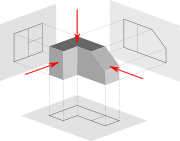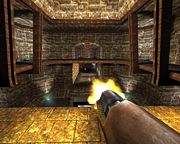Photography
-
One difference between photography and other forms of graphics is that a
photographer, in principle, just records a single moment in reality, with
seemingly no interpretation. However, a photographer can choose the
field
A D V E R T I S E M E N T
of view and angle, and may also use other techniques, such as various
lenses to distort the view or
filters to change the colours. In recent times,
digital photography has opened the way to an infinite number of fast, but
strong, manipulations. Even in the early days of photography, there was
controversy over photographs of enacted scenes that were presented as 'real
life' (especially in
war photography, where it can be very difficult to record the original
events). Shifting the viewer's eyes ever so slightly with simple pinpricks in
the negative could have a dramatic effect.
The choice of the field of view can have a strong effect, effectively
'censoring out' other parts of the scene, accomplished by cropping them out or
simply not including them in the photograph. This even touches on the
philosophical question of what reality is. The human brain processes information
based on previous experience, making us see what we want to see or what we were
taught to see. Photography does the same, although the photographer interprets
the scene for their viewer.
Engineering drawings

Image of a part represented in First Angle Projection
-
An engineering drawing is a type of
drawing that
is technical in nature, used to fully and clearly define requirements for
engineered items. It is usually created in accordance with standardized
conventions for layout, nomenclature, interpretation, appearance (such as
typefaces
and line styles), size, etc.
Computer graphics

A graphic from the video game
OpenArena.
-
There are two types of computer graphics:
raster graphics, where each pixel is separately defined (as in a digital
photograph), and
vector graphics, where mathematical formulas are used to draw lines and
shapes, which are then interpreted at the viewer's end to produce the graphic.
Using vectors results in infinitely sharp graphics and often smaller
files, but, when complex, vectors take time to render and may have larger
filesizes than a raster equivalent.
In 1950, the first computer-driven display was attached to MIT's
Whirlwind I computer to generate simple pictures. This was followed by
MIT's
TX-0 and
TX-2, interactive
computing which increased interest in computer graphics during the late 1950s.
In 1962,
Ivan Sutherland invented
Sketchpad,
an innovative program that influenced alternative forms of interaction with
computers.
In the mid-1960s, large computer graphics research projects were begun at
MIT,
General Motors,
Bell Labs,
and
Lockheed Corporation.
D. T. Ross of
MIT
developed an advanced compiler language for graphics programming.
S.A.Coons, also at MIT, and
J. C. Ferguson at
Boeing, began
work in sculptured surfaces.
GM developed their
DAC-1 system, and other companies, such as
Douglas,
Lockheed, and
McDonnell, also made significant developments. In 1968,
ray tracing was invented by Apple
During the late 1970s,
personal computers became more powerful, capable of drawing both basic and
complex shapes and designs. In the 1980s, artists and graphic designers began to
see the
personal computer, particularly the
Commodore Amiga and
Macintosh, as a serious design tool, one that could save time and draw more
accurately than other methods.
3D computer graphics became possible in the late 1980s with the powerful
SGI computers, which were later used to create some of the first fully
computer-generated
short films at
Pixar. The
Macintosh remains one of the most popular tools for computer graphics in
graphic design studios and businesses.
Modern computer systems, dating from the 1980s and onwards, often use a
graphical user interface (GUI) to present data and information with symbols,
icons and pictures, rather than text. Graphics are one of the five key elements
of
multimedia technology.
3D graphics became more popular in the 1990s in
gaming,
multimedia
and animation.
In 1996, Quake,
one of the first fully 3D
games, was
released. In 1995,
Toy Story,
the first full-length computer-generated animation film, was released in cinemas
worldwide. Since then, computer graphics have become more accurate and detailed,
due to more advanced computers and better 3D modelling software applications,
such as
Cinema 4D.
Another use of computer graphics is
screensavers, originally intended to preventing the layout of much-used GUIs
from 'burning into' the computer screen. They have since evolved into true
pieces of art, their practical purpose obsolete; modern screens are not
susceptible to such burn in artifacts.
|
